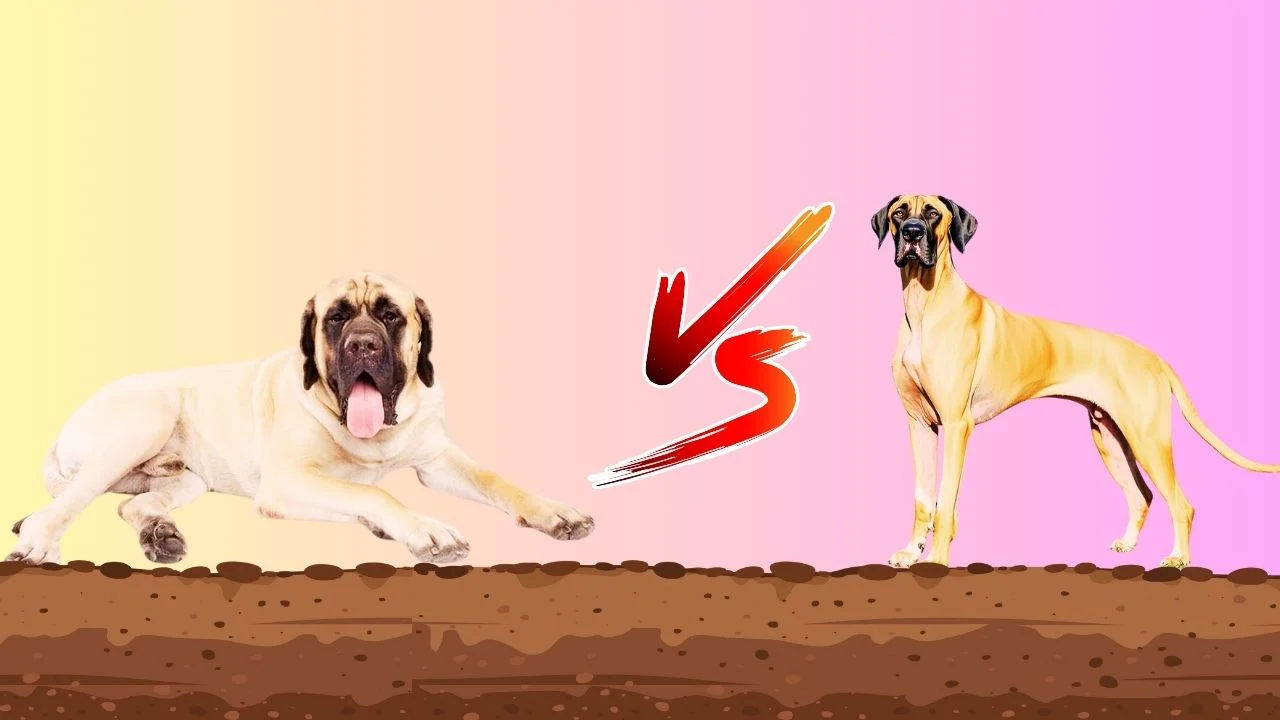Man, I’ve been there standing between a English Mastiff vs Great Dane, trying to figure out which one’s the better fit. A friend of mine went through this exact struggle, and after deep research (and a lot of dog visits), it was clear these two fantastic dog breeds may look similar, but they live completely different lives. One’s a towering, playful athlete, and the other’s a massive, chill guardian. If you want a big dog, both of these breeds would be excellent family companions, but they come with their own similarities and differences.
Quick Look
The Giant Mastiff vs Great Dane comparison shows that the Superb Dane is taller and energetic, while the Giant Mastiff is heavier and more naturally protective. Giant Danes need more space and exercise, while Mastiffs adapt better to smaller homes due to their lower energy levels. Both breeds are affectionate dogs and love their family, but they require plenty of training and socialisation. Due to their large size, they might not be the best choice for first-time dog owners. If you’re looking into other large dogs, you might also consider other breeds like the Stumpy Tail Cattle Dog or Australian Cattle Dog.
Breed Origins and History
Great Dane: The Hunting Giant
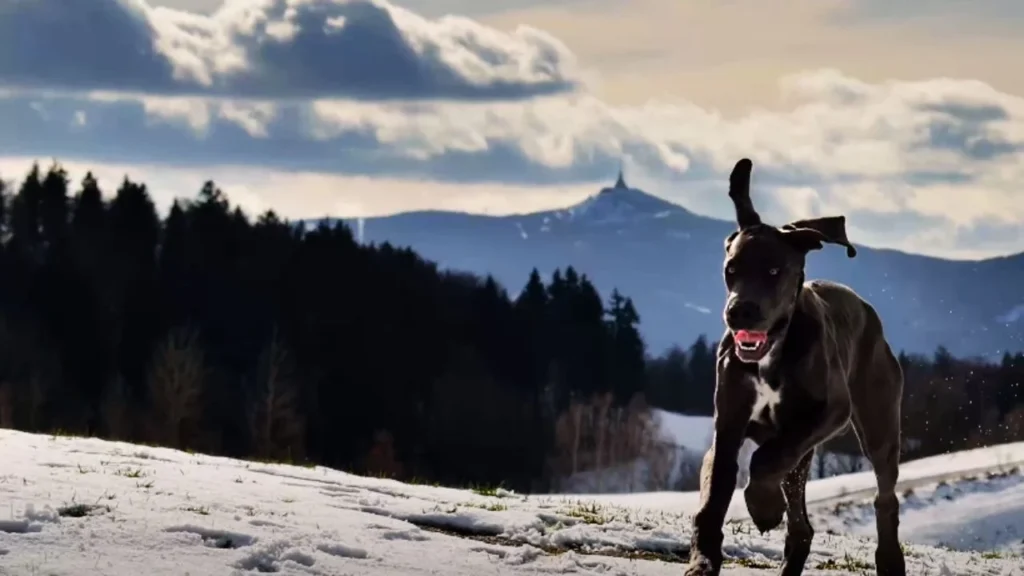
Back in the 16th century, German hunters needed a fast, strong dog to hunt wild boar. That’s how the Superb Dane was born a mix of Mastiff-like strength and Greyhound speed. By the 1800s, they weren’t just hunters anymore. European nobility kept them as purebred dogs because of their loyal and friendly nature.
Today, Giant Danes are still Kind giants, but their hunting instincts make them active and playful, needing around 1–2 hours of daily exercise. These dogs can tower over 3 feet at the shoulder, making their enormous size enough to scare intruders. When standing on their hind legs, they can be as tall as an average person. Their size and weight range from 110–175 lbs. When comparing Giant Mastiff vs Superb Dane size, the Superb Dane tends to be taller, while the English Mastiff is heavier and more muscular.
English Mastiff: The Ancient Guardian
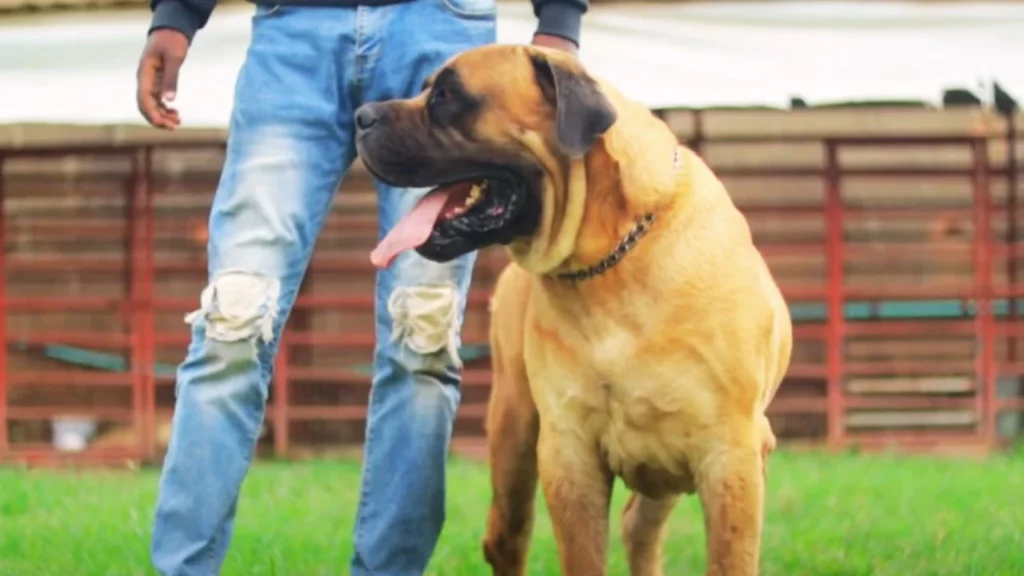
Mastiffs go back over 2,000 years, guarding homes, palaces, and even fighting alongside Roman soldiers. Like the Mastiff breeds before them, they were bred for protection and strength, often serving as protection dogs. Their large size makes them intimidating, but their desire to please their owners and their love towards their family make them Kind giants at heart.
Mastiffs are more laid-back and reserved, often preferring to stay close to their family rather than seeking attention from strangers. Unlike Giant Dane, Mastiffs are low-energy and are happy with just an hour of exercise per day. Mastiff puppies require early socialization and plenty of training to ensure they grow into well-behaved companions. They are absolute heavyweights, ranging from 150 to 230 lbs, with some reaching 300 lbs, making them one of the largest dog breeds by weight.
Physical & Appearance Differences
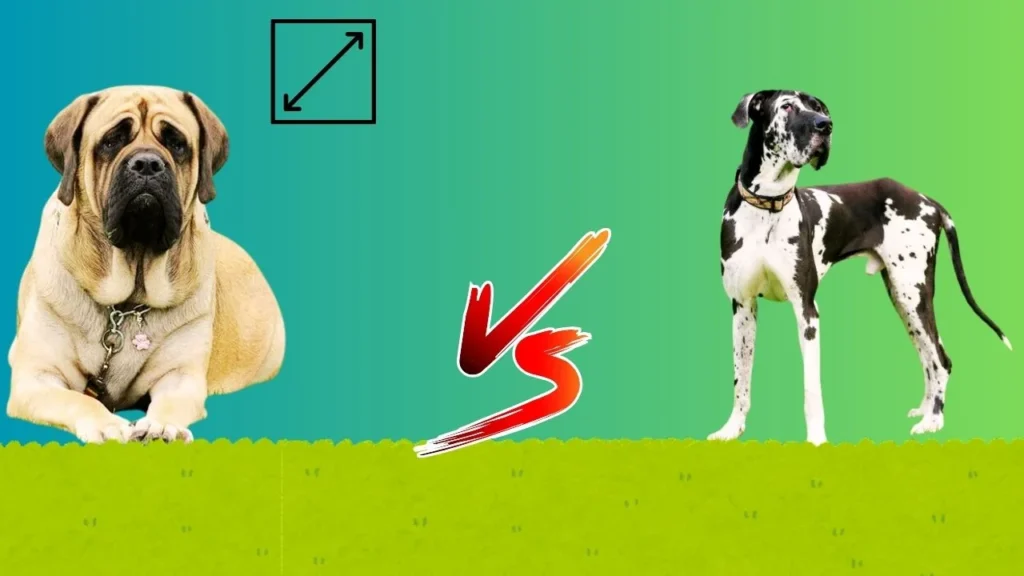
Size & Weight
English Mastiff vs Great Dane: The Superb Dane is tall and lean, standing 30-34 inches and weighing 110-175 pounds. It has a sleek body and long legs, built for agility.
The Giant Mastiff is shorter but heavier, measuring 27-32 inches but weighing 160-230+ pounds. It has a stocky, muscular build, designed for strength.
Body Structure & Movement
Giant Dane have a narrow waist, deep chest, and athletic frame, making them fast and agile. Mastiffs are broader, denser, and powerful, moving slowly but with great strength. Dogster is reader-supported, providing insights into these majestic breeds. Click to see the difference. Queensland Heeler vs Australian Cattle Dog.
Coat & Colors
Giant Dane come in 7 colors, including black, fawn, merle, and harlequin. Mastiffs have 3 shades fawn, apricot, and brindle, always with a black face mask.
Face & Expression
Superb Dane and the English mastiff have a long, narrow snout with curious, friendly eyes. Mastiffs have a broad, wrinkled face with droopy jowls, giving them a serious and protective look.
Drooling & Shedding
Mastiffs Dribble heavily, especially after drinking or eating. Giant Dane Dribble less but still shed moderately, like Mastiffs. Either of these breeds can be prone to drooling.
Temperament & Personality
Choosing between a Superb Dane and a Mastiff dog breed depends on their personalities. Both breeds are loving and loyal, but their temperaments have key differences that make them better suited for different lifestyles. When considering a Great Dane vs Mastiff comparison, it’s important to note that Giant Dane typically have a shorter lifespan compared to Mastiffs. Since a dog will live many years as part of your family, understanding their traits can help you make the right choice. The Mastiff and the Great Dane each have distinct characteristics to consider.
Great Dane
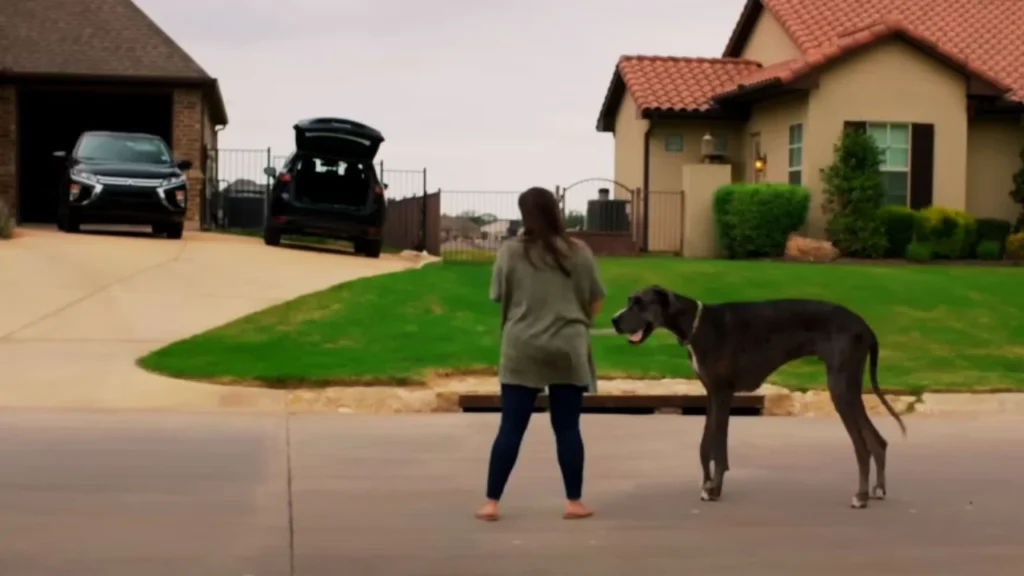
Superb Danes are often called “Kind giants” for a reason. They’re social, friendly, and love being around people. If you’re looking for a dog that enjoys cuddling on the couch but also has bursts of playful energy, this breed is a great fit. These dogs are naturally affectionate and eager to please, making them great with children and ideal for families. Owning a dog like a Great Dane means you’ll have a loyal companion that thrives on human interaction.
In fact, over 80% of Superb Dane owners describe them as extremely affectionate with their families. However, Giant Dane don’t make the best guard dogs they may bark at a stranger, but they’re more likely to greet them than act aggressively. When it comes to other pets, Great Danes typically get along well with dogs and even cats. Early socialization is key, but their playful and easygoing nature makes them adaptable to multi-pet households.
A Superb Dane puppy grows quickly, and by adulthood, they reach a minimum height of about 30 inches. While they’re a popular breed, they suffer from several health issues, including heart disease and bloat, which can impact their lifespan. Potential owners should be aware of these concerns before making a decision.
English Mastiff
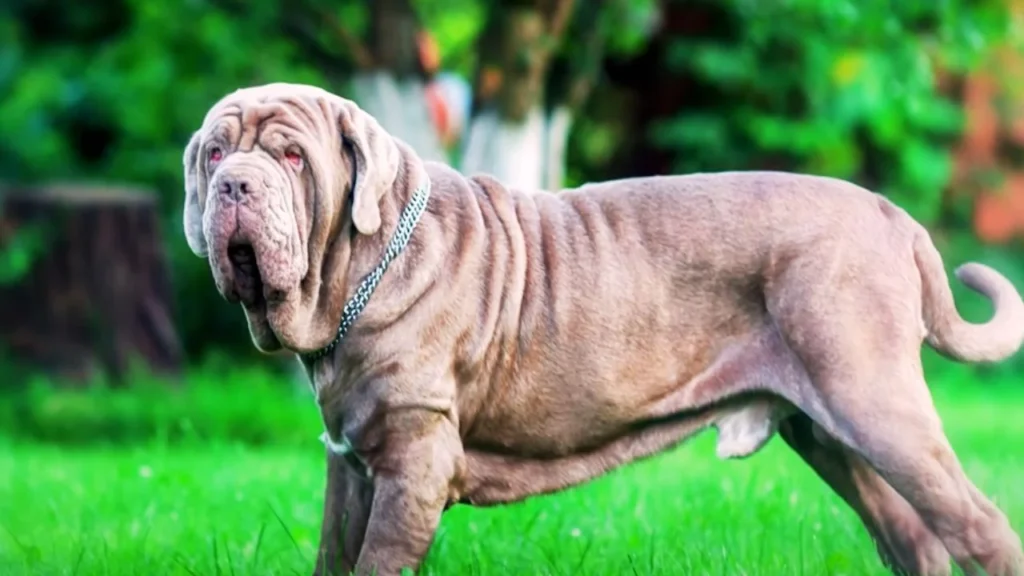
The Mastiff is often described as a gentle but powerful guardian, making it an excellent guard dog. They’re calm, confident, and deeply loyal to their family, making them one of the best natural protectors. Unlike the outgoing Superb Dane, a Mastiff is more reserved with strangers, but they are not aggressive unless they sense a real threat. Owning a dog like a Mastiff means having a strong and dependable companion that takes its role as a protector seriously.
One interesting fact? Nearly 85% of Mastiff owners say their dog acts like a couch potato indoors but instantly becomes alert when something feels “off.” They may not be as playful as a Superb Dane, but their patience and protective instincts make them fantastic family dogs, especially for those who want a more laid-back giant breed.
Since Mastiffs are hunting dogs by ancestry, their instincts are strong, and early training is essential. While these dogs need consistent socialization, they are generally great with children and can be good with other pets when properly introduced.Their breed standard emphasizes their massive size and muscular build, which can be intimidating but also reassuring for dog lovers looking for a protective yet affectionate pet. The comparison of English Mastiff vs Great Dane often highlights these traits, as both breeds are known for their impressive stature and loyal nature.
Training & Intelligence
Great Dane: Smart but Sensitive
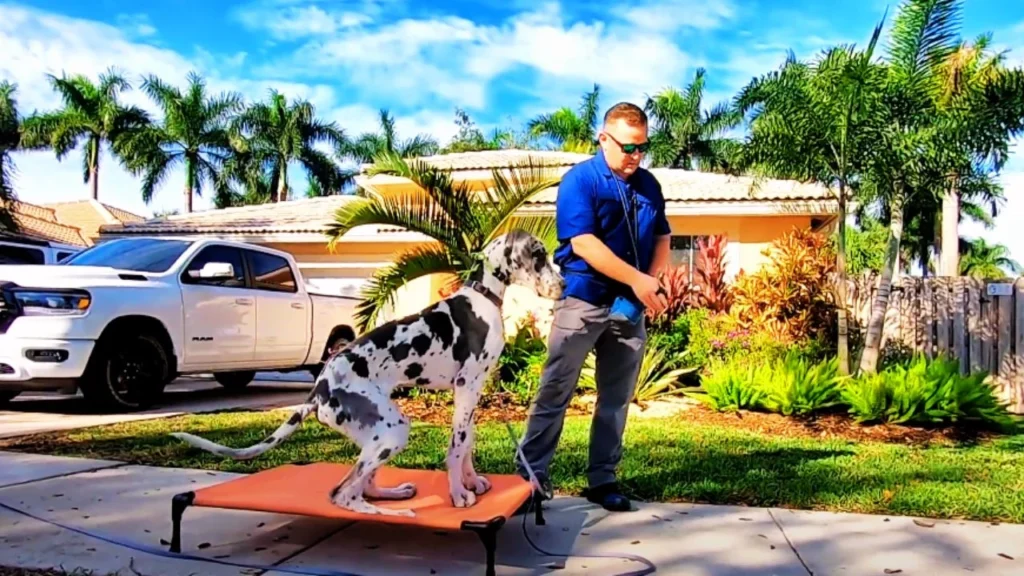
Giant Dane are quick learners and eager to please, making them easier to train. They respond best to positive reinforcement like treats and praise. Start training early because they grow fast up to 2 inches per month as puppies. Socialization is key before 4 months old to prevent fearfulness later.
English Mastiff: Stubborn but Loyal
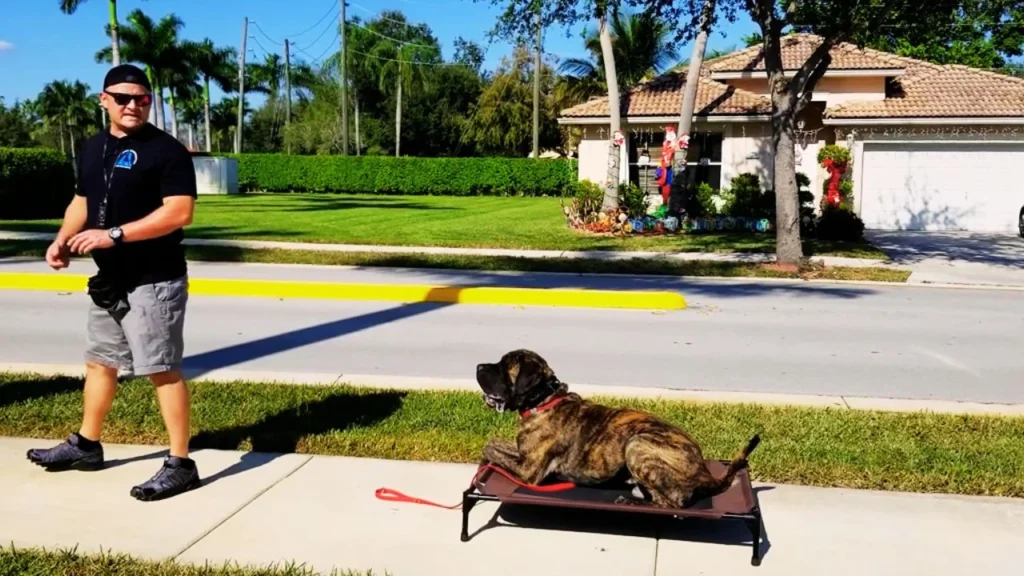
Mastiffs are intelligent but stubborn. They listen when they feel like it, so training takes patience. Keep sessions short 10 to 15 minutes or they’ll lose interest. Harsh corrections won’t work; gentle, consistent training is best. They’re slow learners but deeply loyal once trained. When comparing English Mastiff vs Great Dane, Mastiffs tend to be more stubborn, requiring extra patience during training.
Exercise & Activity Levels
From my experience, the Superb Dane needs around 60 to 120 minutes of activity each day. They enjoy long walks, runs, and even off-leash playtime in a fenced area. While they are large dogs, they aren’t overly energetic like some working breeds, so a mix of structured exercise and play is enough to keep them happy. They also do well with mental stimulation, such as obedience training or puzzle toys, to keep their intelligent minds engaged.
Meanwhile, the Mastiff requires slightly less activity, around 30 to 60 minutes daily. These gentle giants are naturally more laid-back and prefer slow, steady walks over high-intensity exercise. Unlike Giant Dane, Mastiffs are prone to joint issues if overworked, so it’s best to avoid excessive running or jumping, especially when they are puppies. They enjoy interactive play like short fetch sessions, but are happiest lounging around with their owners. Superb Danes are generally easy to train, making playtime even more engaging.
Grooming Needs
Both breeds are low-maintenance, but Mastiffs need more care due to drooling and skin folds.
- Shedding: Mastiffs shed more, especially seasonally. Brush both 2-3 times a week.
- Bathing: Every 4-6 weeks; Mastiffs may need extra cleaning for skin folds.
- Drooling: Mastiffs Dribble a lot; Giant Dane Dribble less. Keep a cloth handy.
- Nail Trimming: Every 2-3 weeks to prevent cracking.
- Ear Cleaning: Weekly for Giant Dane, every 2 weeks for Mastiffs to prevent infections, as dogs and don’t neglect their ear hygiene.
Health & Lifespan
Both the Superb Dane and Mastiff are big breeds recognized by the American Kennel Club (AKC). Due to their massive size, both are prone to health issues, particularly hip dysplasia, which is common in giant dogs. Giant Dane typically live 7-10 years, while Mastiffs have a slightly shorter lifespan of 6-10 years. Regular vet check-ups and a healthy diet are essential to keep these powerful dogs in top shape.
Real-Life Considerations
Mastiffs and Giant Dane are among the biggest dog breeds in the world. If you’re considering a puppy from a breeder, ensure they conduct health screenings for conditions like hip dysplasia. These giant dogs require responsible ownership and dedicated training to manage their size and strength.
Space Needs
Giant Dane can reach heights of up to 32 inches, while Mastiffs are heavier, sometimes exceeding 230 pounds. While a Superb Dane can adapt to smaller homes, a Mastiff needs more space to move comfortably. Ideally, a home with at least 1,500 sq. ft. is best for these big breeds. Kennel clubs and breed organizations often recommend a spacious environment to accommodate their needs.
Kids & Other Pets
Giant Dane are playful and social, but their size can accidentally knock over small kids. Mastiffs, on the other hand, are calm and protective, making them excellent guardian dogs. If socialized properly, both breeds can live peacefully with other pets. When introducing a new pup to an existing pet, it’s important to supervise interactions, as these powerful dogs may unintentionally overwhelm smaller animals.
Travel & Transportation
Transporting a Superb Dane or Mastiff requires planning. Due to their size, a large SUV is necessary for comfortable car rides. Airlines typically don’t allow dogs over 100 pounds in the cabin, making air travel difficult. English Mastiff vs Great Dane the Great Dane, being lighter than a Mastiff, is somewhat easier to move. Many owners invest in durable crates to safely transport their massive dogs.
Key Takeaways
- The Great Dane is taller and more playful, while the Mastiff is heavier and more protective. Like many dogs, both breeds have unique temperaments and care needs.
- Great Danes require more exercise, whereas Mastiffs are quieter and adapt better to smaller homes.
- Both breeds need proper training; Giant Dane learn quickly, while Mastiffs can be stubborn. These dogs look impressive and require consistent guidance.
Conclusion
When comparing the Great Dane and the Giant Mastiff, the choice depends on your lifestyle. If you want a tall, energetic, and playful working dog, the Great Dane is a great fit. If you prefer a massive, calm, and protective companion, the Mastiff would be the better choice. Both are recognized by the AKC as large breeds with unique characteristics. If you’re looking for a quiet dog that doubles as a guardian, the Mastiff is an excellent choice. If you want a dog that stands out with its towering height and fun personality, the Great Dane is ideal. Whichever breed you choose, proper care, space, and training will ensure a happy and healthy life for your dog.
FAQs
Q1. Which breed is better for first-time owners, Great Dane or English Mastiff?
Great Danes are easier to train and more social, making them a better choice for first-time owners. Mastiffs are more independent and protective, requiring experienced handling. This breed comparison highlights their distinct temperaments and training needs.
Q2. Do Great Danes and Giant Mastiffs get along with kids?
Yes, both breeds are great with kids! Great Danes are playful and friendly, while Mastiffs are calm and protective. However, due to their size, supervision is always recommended.
Q3. Can a Great Dane or Giant Mastiff live in an apartment?
Mastiffs adapt better to small spaces since they are less active. Great Danes need more room to move around, making them better suited for larger homes with yards. Understanding each breed’s space requirements can help in making the right choice, especially if you love dogs and great danes don’t have a lot of space.
Q4. Which breed has more health issues, Great Dane or English Mastiff?
Both breeds have health risks, but Great Danes are prone to bloat and heart issues, while Mastiffs often struggle with joint problems and obesity. Regular vet check-ups are essential for managing a Mastiff’s health concerns.

